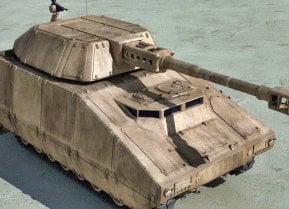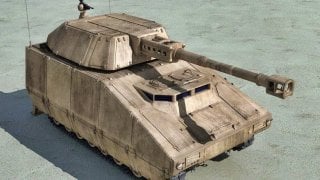XM1202: Why Tank Designed to Replace the M1 Abrams (and Failed)
The U.S. Army’s M1 Abrams main battle tank has served faithfully since 1980. The XM1202 was designed to replace the Abrams, but it never occurred.
XM1202, A Primer: The U.S. Army’s M1 Abrams main battle tank has served faithfully since 1980 and proved itself to be the premier MBT in the 1990s and early 2000s.
The Abrams’ combat superiority over the vaunted Soviet-designed T-72 MBT was starkly demonstrated during Operation Desert Storm in 1991, especially the Battle of 73 Easting, which is often described as “the last great tank battle of the 20th century.”
Time marches on, however, and the XM1202 Mounted Combat System (MCS) was proposed as a successor to the M1.
However, in spite of the $18.1 billion spent on its development, the MCS failed to make the final cut.
XM1202: Big Shoes to Fill
The XM1202 traces its roots to 1999 when then-Army Chief of Staff General Eric K. Shinseki set in motion the Manned Ground Vehicles (MGV) program, which in turn was part of the Army’s Future Combat Systems (FCS) program. Development began in 2002 when DARPA awarded four contracts to different designers to oversee the development of common air-transportable vehicles that could be transported on a C-130 fully assembled.
By the mid-2000s development had shifted to General Dynamics and BAE Systems, resulting in the Common Chassis that formed the basis for the XM1201 Reconnaissance and Surveillance Vehicle, XM1202 MCS XM1203 non-line-of-sight cannon, XM1204 non-line-of-sight mortar, XM1205 Field Recovery, and Maintenance Vehicle, XM1206 Infantry Carrier Vehicle, XM1207/8 Medical Vehicle, and XM1209 Command and Control Vehicle.
Common Chassis for all of those FCS vehicles notwithstanding, the XM1202 utilized advanced technologies that separated it from the rest of the MGV pack. Some of these technologies included the XM360 Light Weight Gun coupled to an autoloader that could fire standard 120mm rounds such as the M829A3 APFSDS-T as well as the new XM1111 guided rounds.
These rounds were designed for LOS/BLOS engagements and could penetrate tanks and other vehicles in a “top-attack” or high angle fashion, and also had the versatility to strike structures and bunkers.
While using the same bore size as the Abrams’s M256 main gun, the XM360 was 2,100 pounds lighter and also featured an Ammunition Data Link to use programmable ammunition, as well as a higher pressure limit to handle more powerful kinetic energy rounds.
Meanwhile, for targets such as troop formations or unarmored trucks for which the 120mm main gun might be a tad bit of overkill, the XM1202 housed either the time-honored Browning .50 caliber (12.7mm) M2HB Machine Gun AKA “Ma Deuce,” or a 40mm Grenade Launcher.
The vehicle only had a crew of two, a Driver and a Commander who had to fulfill the duties of the Gunner. In order to relieve this smaller crew of mental data overload during Clausewitz’s ever-pesky “fog of war,” the XM1202 incorporated new electronics such as 2nd-Generation FLIR for the Commander as well as several next-generation communications/sensor technology that increased situational awareness.
To maximize the survivability of that two-person crew, the vehicle sported composite and bolt-on add-on armor that significantly increased protection against 14.5mm machine-gun fire as well as up to 45mm autocannon rounds.
The XM1202 Gets X’ed Out
Alas, in spite of all of these advanced features, in 2009 the Army canceled the XM1202 project due to budget cuts and the lack of protection against IEDs — the latter was a particularly big concern due to insurgent tools and tactics in Iraq and Afghanistan alike. No complete tank was assembled before the program was cut.

A prototype turret and multiple different hulls were completed but never fitted together.
So, in the meantime, the M1 Abrams soldiers on, with not only the United States (at least with the Army, anyway, as the Marine Corps is phasing out its tanks), but with Australia, Egypt, Iraq, Kuwait, Morocco, Ukraine and Saudi Arabia.
How well the upgraded M1s would fare against new Russian tanks such as the T-90 and T-14 Armata remains a purely theoretical exercise as this is writing.
About the Author
Christian D. Orr is a former Air Force officer, Federal law enforcement officer, and private military contractor (with assignments worked in Iraq, the United Arab Emirates, Kosovo, Japan, Germany, and the Pentagon). Chris holds a B.A. in International Relations from the University of Southern California (USC) and an M.A. in Intelligence Studies (concentration in Terrorism Studies) from American Military University (AMU). He has also been published in The Daily Torch and The Journal of Intelligence and Cyber Security.


